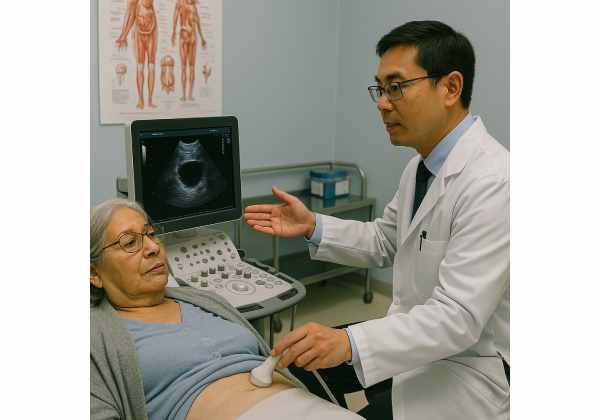
Abdominal aortic aneurysm (AAA) is a life-threatening vascular condition where the lower part of the aorta—the body’s largest artery—becomes weakened and bulges outward. Often silent for years, an abdominal aortic aneurysm can enlarge undetected until it ruptures, causing internal bleeding and high mortality. Timely recognition, risk factor management, and early treatment are crucial to prevent serious complications. This in-depth guide explains abdominal aortic aneurysm from causes and risk factors to diagnosis, symptoms, treatment, and preventive management for both patients and caregivers.
Table of Contents
- In-Depth Explanation of Abdominal Aortic Aneurysm
- Understanding Causes, Consequences, and Risk Factors
- Symptom Awareness and Diagnostic Approaches
- Modern Treatments and Management Strategies
- Frequently Asked Questions
In-Depth Explanation of Abdominal Aortic Aneurysm
An abdominal aortic aneurysm is defined as a localized dilation or ballooning of the abdominal segment of the aorta, usually measuring at least 3 centimeters in diameter or 50% larger than the normal size. The aorta, running from the heart through the chest and abdomen, supplies oxygen-rich blood to much of the body. Its abdominal portion is especially susceptible to damage from atherosclerosis and aging.
Why does abdominal aortic aneurysm matter?
- The risk with AAA lies in its potential to rupture. A ruptured abdominal aortic aneurysm leads to catastrophic internal bleeding, often resulting in death if not treated immediately.
- Even when unruptured, an AAA can affect surrounding organs and blood flow, causing pain, blood clots, or blockages.
Key characteristics of abdominal aortic aneurysm:
- Location: Below the kidneys (infrarenal aorta) in most cases, but can occur anywhere in the abdominal aorta.
- Growth: Most aneurysms grow slowly, but some expand rapidly and unpredictably.
- Symptoms: Typically silent until the aneurysm is large or ruptures, making early detection vital.
Who is affected?
Abdominal aortic aneurysm most often occurs in adults over 65, especially men, smokers, and those with cardiovascular disease. Its prevalence increases with age.
Why education is important:
Awareness of the risks, symptoms, and screening recommendations for abdominal aortic aneurysm can save lives. With early intervention, many ruptures and related complications are preventable.
Understanding Causes, Consequences, and Risk Factors
The development of abdominal aortic aneurysm is the result of complex interactions between genetic factors, lifestyle choices, and medical conditions that weaken the aortic wall over time.
Main Causes of Abdominal Aortic Aneurysm
- Atherosclerosis (Arterial Hardening):
The buildup of plaque—fat, cholesterol, and other substances—in the artery wall leads to chronic inflammation and loss of elasticity, making the aorta prone to bulging. - Genetic and Connective Tissue Disorders:
Inherited conditions like Marfan syndrome or Ehlers-Danlos syndrome can cause early and severe weakening of the aorta, increasing aneurysm risk at a younger age. - Chronic High Blood Pressure (Hypertension):
Elevated pressure in the arteries puts continuous strain on the vessel wall, accelerating degeneration. - Infection and Inflammatory Diseases:
Rarely, infections of the aortic wall (mycotic aneurysms) or inflammatory vasculitis can weaken the vessel and lead to aneurysm. - Trauma or Injury:
Direct injury to the abdomen can rarely cause aneurysm formation, especially in the setting of preexisting arterial disease.
Risk Factors for Developing Abdominal Aortic Aneurysm
- Age:
Most AAAs develop after age 60, with risk rising dramatically in people over 65. - Sex:
Men are four to six times more likely to develop an abdominal aortic aneurysm than women, though women’s aneurysms rupture more readily at smaller sizes. - Family History:
A first-degree relative with AAA increases risk several-fold. - Smoking:
Smoking is the single most significant modifiable risk factor, both for developing and for rapid growth of an abdominal aortic aneurysm. - High Blood Pressure:
Chronic hypertension adds to vessel wall stress. - Atherosclerosis and Heart Disease:
Underlying cardiovascular disease and high cholesterol further elevate risk. - Ethnicity:
Individuals of Caucasian descent are at higher risk, but AAA can affect any racial or ethnic group.
Potential Complications and Effects
- Rupture:
The most feared complication, rupture of an abdominal aortic aneurysm, causes sudden, severe pain and internal hemorrhage. Emergency surgery is required, but survival rates remain low. - Thrombosis or Embolism:
Blood clots may form within the aneurysm and travel to other arteries, risking stroke or limb ischemia. - Compression of Nearby Structures:
Large AAAs can press on nearby nerves, veins, or organs, causing pain or swelling in the legs.
Preventive tips:
- Quit smoking to slow aneurysm growth and lower risk.
- Manage blood pressure and cholesterol.
- Get regular check-ups and screening if you have risk factors or a family history of abdominal aortic aneurysm.
- Maintain a heart-healthy lifestyle—diet, exercise, and weight management.
Knowing the causes and risk factors for abdominal aortic aneurysm is the first step in prevention and early detection.
Symptom Awareness and Diagnostic Approaches
The most dangerous feature of an abdominal aortic aneurysm is its tendency to remain silent for years. Because symptoms are rare before rupture, most AAAs are detected incidentally during exams or imaging for other reasons.
Common Symptoms of Abdominal Aortic Aneurysm
- Asymptomatic:
Most people have no symptoms until the aneurysm is large or ruptures. - Abdominal, Back, or Flank Pain:
Discomfort may be deep, aching, or throbbing, often centered near the navel or lower back. - Pulsatile Abdominal Mass:
In some cases, a doctor may feel a pulsating bulge in the abdomen during a physical exam. - Symptoms of Rupture:
Sudden, severe, tearing pain in the abdomen or back; rapid heart rate; low blood pressure; dizziness or fainting; and signs of shock. This is a medical emergency.
When to Seek Immediate Medical Help
- Sudden, severe abdominal or back pain
- Fainting, dizziness, or weakness
- Rapid heartbeat and pallor
Diagnostic Strategies for Abdominal Aortic Aneurysm
- Physical Examination:
Although some AAAs can be detected as a pulsatile mass, many are missed, especially in overweight individuals. - Abdominal Ultrasound:
The gold standard for initial screening and diagnosis—noninvasive, safe, and accurate for measuring aneurysm size. - CT (Computed Tomography) Scan:
Provides detailed cross-sectional images, useful for surgical planning and evaluating for rupture. - MRI (Magnetic Resonance Imaging):
Alternative for patients allergic to contrast or when further detail is needed. - Screening Recommendations:
- Men aged 65–75 who have ever smoked should have a one-time abdominal ultrasound.
- Individuals with a family history of abdominal aortic aneurysm may need earlier or more frequent screening.
- Women with multiple risk factors should discuss screening with their healthcare provider.
Tips for early detection:
- Know your risk and ask about screening if you are eligible.
- Don’t ignore persistent, unexplained abdominal or back pain.
Prompt diagnosis is the best way to prevent rupture and improve survival outcomes.
Modern Treatments and Management Strategies
Management of abdominal aortic aneurysm depends on its size, growth rate, symptoms, and the overall health of the individual.
Surveillance and Conservative Management
- Small AAAs (<5.5 cm):
Most small, asymptomatic aneurysms are monitored with regular ultrasound or CT scans (every 6–12 months). - Lifestyle Modifications:
- Stop smoking immediately.
- Control blood pressure and cholesterol.
- Maintain a healthy weight and exercise regularly.
- Medical Therapy:
No medication can shrink an aneurysm, but statins, beta blockers, and antiplatelet drugs help control risk factors and cardiovascular health.
Surgical Treatment Options
- Open Surgical Repair:
- The aneurysmal segment is replaced with a synthetic graft.
- Involves abdominal surgery and a longer recovery but offers durable results.
- Best suited for younger, healthier patients.
- Endovascular Aneurysm Repair (EVAR):
- A minimally invasive procedure where a stent-graft is inserted through the groin arteries and placed inside the aneurysm.
- Shorter recovery and less pain; suitable for high-risk or older patients.
- Requires long-term monitoring for stent position and leaks.
- Emergency Surgery:
Required for ruptured abdominal aortic aneurysm. Even with urgent surgery, survival rates are lower, emphasizing the need for early diagnosis and elective repair when indicated.
Living with Abdominal Aortic Aneurysm
- Regular Follow-Up:
Attend all scheduled imaging and medical appointments. - Recognize Emergency Symptoms:
Know the warning signs of rupture and seek immediate help if they occur. - Educate Family and Caregivers:
They should also recognize symptoms and understand your care plan. - Optimize Cardiovascular Health:
Maintain heart-healthy habits to reduce the risk of further vascular disease.
Practical Advice for Patients
- Discuss the risks and benefits of all treatment options with your healthcare team.
- Carry a medical alert card if you have a large or untreated abdominal aortic aneurysm.
- Consider joining a support group for people with vascular conditions.
In summary:
With careful monitoring, proactive lifestyle changes, and timely surgical intervention, most people with abdominal aortic aneurysm can prevent rupture and maintain a good quality of life.
Frequently Asked Questions
What is an abdominal aortic aneurysm and why is it dangerous?
An abdominal aortic aneurysm is a bulging or enlargement of the lower aorta. It’s dangerous because rupture can cause severe internal bleeding and is often fatal without emergency surgery.
Who is at highest risk for developing an abdominal aortic aneurysm?
People over 65, especially men, smokers, those with a family history, or atherosclerosis, have the highest risk for abdominal aortic aneurysm.
How is an abdominal aortic aneurysm detected?
Most are found using abdominal ultrasound, CT scan, or sometimes during physical examination. Screening is recommended for high-risk groups.
What are the symptoms of an abdominal aortic aneurysm?
Most AAAs have no symptoms until they rupture. Some may cause persistent abdominal, back, or flank pain, or a pulsatile mass in the abdomen.
How is an abdominal aortic aneurysm treated?
Small aneurysms are monitored, while large, rapidly growing, or symptomatic AAAs may require surgery—either open repair or endovascular stenting.
Can abdominal aortic aneurysm be prevented?
Reducing risk factors—quitting smoking, controlling blood pressure and cholesterol, maintaining a healthy lifestyle, and regular screening—can prevent many AAAs.
What should I do if I’m diagnosed with an abdominal aortic aneurysm?
Follow your doctor’s recommendations for monitoring or treatment, manage your cardiovascular health, and know the warning signs of rupture.
When is surgery necessary for an abdominal aortic aneurysm?
Surgery is advised if the aneurysm is larger than 5.5 cm, growing quickly, or causing symptoms, or if there are signs of imminent rupture.
Disclaimer:
The information provided in this article about abdominal aortic aneurysm is for educational purposes only and should not be used as a substitute for medical advice, diagnosis, or treatment. Always consult your healthcare provider with any questions or concerns. Never disregard professional medical advice because of something you have read here.
If this article helped you understand abdominal aortic aneurysm, please consider sharing it on Facebook, X (formerly Twitter), or your favorite social platform. Your support enables us to keep providing high-quality, reliable health content—thank you for spreading the word!










